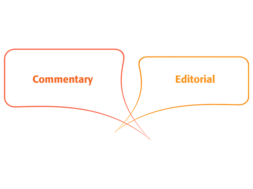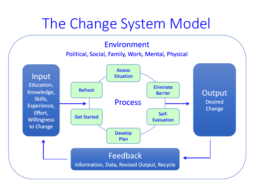
Maybe Clayton Christensen Was Right … Disruption is Coming to Higher Education
By John King Ed.D.
In 2013 I attended a symposium in Boston where Clayton Christensen made a presentation on disruptive theory and the future of higher education. At the same symposium, Paul LeBlanc made a presentation on a new venture begun by Southern New Hampshire University called College for America offering a competency-based curriculum designed for working adults. I became an immediate fan of both and have followed them ever since.
Today, as we face the worst health crisis in modern times which has disrupted the world in general and higher education in particular, I can see how both men may play a large role in how higher education transitions in the aftermath of the coronavirus pandemic.
I was familiar with Dr. LeBlanc as he had chaired an accreditation team that reviewed a college on whose Board of Trustees I served. I was once again impressed by him as he took the time at the symposium to come over and say hello and tell me how much he enjoyed the campus visit and how impressed he was by the college.
I was excited to hear Dr. Christiansen having read his book on disruption in higher education. I was immediately impressed by Dr. Christensen by his candor and openness. He began his presentation by apologizing for his presentation style revealing that a stroke some years earlier cause him to lose his ability to speak and in the relearning process he would stare down at the floor to focus his thoughts. He hooked me when providing an example of Peter Drucker’s idea that “The customer rarely buys what the company thinks it is selling him.” He told the story of a consulting project he completed for McDonald’s. The fast-food giant asked him to tell them how they could increase sales and efficiencies at their drive-up windows in the morning rush hour. After a number of days observing traffic that most of the sales volume was realized by working adults who were purchasing milk shakes. When they interviewed customers, they discovered that food items were too unwieldy and messy but that milkshakes fit conveniently in the car’s cup holder, were neat and easy to consume and the consistency of the shake keep the customers’ appetites satisfied until lunchtime. Dr. Christensen’s advice to McDonald’s was to reposition the milkshake machines closer to the drive-up windows. I was able to share with Dr. Christensen that I would regularly attend a board meeting at a college in Connecticut. After the meeting on my three-hour commute back to New Jersey, I would stop at a McDonald’s and pick up a milkshake for the drive home for the same exact reasons.
Dr. Christensen defined disruptive innovation as “a process by which a product or service relentlessly moves upmarket, eventually displacing established competitors.” According to the Christensen Institute disruption requires three elements: 1) Enabling Technology that makes a product more affordable and accessible to a broader population; 2) an Innovative Business Model that targets new consumers who previously did not buy your product or the least-profitable consumers, and 3) a Coherent Value Network in which all stakeholders are better off when the disruptive technology prospers.
In 2013 Dr. Christensen predicted that the bottom 25% of every college and university tier would disappear or merge within the next decade.
He saw the business model of the traditional higher education institution as broken and unable to sustain itself in an era of increasing cost and competition. He viewed online learning as the disrupter to the traditional model of higher education. He believed that online learning would give birth to a new business model that would disrupt the traditional higher education business model. This gave birth to “Mega-Universities” like Southern New Hampshire, Western Governors, Arizona State, and Perdue. Others are reimagining parts or all their operations to reflect the new “Mega-University” business model. Companies like Microsoft and Google are trying to take advantage of this shift and become major players in this disruption by partnering with MIT and Berkley respectively.
It is ironic that the Covid-19 pandemic has brought about a situation in which online learning has indeed disrupted the traditional on-site education model of all colleges and universities and threatens to be a dominant instructional model as institutions plan for their future. Also, because of the financial drain of the pandemic, many colleges and universities are uncertain about their ability to sustain their operations in the future. It is conceivable that many of these institutions will not survive.
This fall will be a challenge for most colleges and universities. McKinsey & Company estimated that 25% of colleges and universities returning to a controlled virus scenario will experience budget shortfalls of at least 5%. The Detroit Free Press reported that the University of Michigan was anticipating financial losses in the $400 million to $1 billion range. Clemson University anticipated a revenue reduction of over $7 million if football was canceled. In addition to lost sports revenue colleges and universities are anticipating budget shortfalls as a result of reduced state and/or local funding, lower tuition revenue due to reduced enrollments, shrinking endowments and new donations, and higher operating costs due to technology costs or post-pandemic social distancing and safety regulations. Many institutions are facing lawsuits from students demanding tuition and fee reimbursements for the shift from in-person to online classes. Colleges and universities are already working to alleviate anticipated budget shortfalls through faculty and staff layoffs and furloughs, hiring freezes, pay cuts, and elimination and/or contraction of some academic and sports programs, and campus closures. It is also possible that we will see many college closures and or consolidation of institutions.
There is also some panic that students will not be returning to school this fall choosing to enroll close to home, take a gap year and/or working to save to be able to pay for school. Parents might have something to say about how their children will return to school. In a recent survey conducted by the Chronicle of Higher Education, 57% of surveyed parents indicated that they would continue their child’s education at the same college or university if they offered online education only, 7% said that they definitely would not return to the same college and 35% said that they were unsure. A survey, conducted by the Art & Science Group, found that one in six high-school seniors who expected to attend a four-year college full-time before the pandemic now say they will choose a different path. In particular: 1) Three out of five students said they were concerned about their ability to attend their first-choice colleges. 2) A majority of the 17% of students who didn’t think they would enroll full time at a four-year college expected to take a gap year or enroll part-time in a bachelor’s program. 3) About 32% of students said they were considering less-expensive institutions.
Colleges and universities are offering numerous incentives to lure students to their campuses in the fall.
Southern New Hampshire University is offering a one-time Innovation Scholarship covering one-hundred percent of tuition for all incoming freshmen. Tuition will revert to $10,000 per year for subsequent years.
The University of Nebraska will offer free tuition to students whose families are below the state’s median income level. Michigan State University will freeze tuition for the 2021-22 academic year.
Amidst all of the challenges for colleges and universities moving forward there are also opportunities. Unemployment in the United States is projected to be at 20% well into 2021. Many of the companies and industries in which these people were employed will not be returning requiring massive retraining to move the economy toward full employment. Surviving and emerging industries will demand an immediate supply of trained workers. Current college students and graduating seniors may opt to seek employment rather than attend school until tuition fits their financial position. Affordable, flexible, timely retraining programs will be required to meet this need. Competency-based and online education may be the best alternatives to achieve this goal. The Department of Education has rolled out new distance learning rules providing more flexibility in testing competency-based or other innovative programming. Stress, strain and burn-out among health-care workers and first-responders, not to mention future waves of the Covid-19 virus, may create a need for future workers in these vital fields. New programming areas in artificial intelligence, robotics, immunology and epidemiology may arise to serve the emerging post-pandemic economy. Smart colleges and universities will be developing plans to attract and serve these emerging student needs.
At the beginning of this article, in addition to Clayton Christensen, I also mentioned Paul LeBlanc. Dr. LeBlanc is President of the University of Southern New Hampshire. In 2002 I was serving in an interim position at a two-year college in New Hampshire. Southern New Hampshire University was a small local university that actually rented classrooms at the institution I was working at. Dr. LeBlanc arrived at Southern New Hampshire in 2003. By the time I met him in 2013, Dr. LeBlanc was already transforming Southern New Hampshire and rolling out his College for America program which was a major new step forward in competency-based education at scale. College for America was offering one associated degree program in General Studies focused on the needs of companies and organizations to quickly and economically develop essential work skills in their employees. College for America now also offers associate degrees in Healthcare Management and Bachelor’s degrees in Communications, Management and Healthcare Management. Since that time Southern New Hampshire University has grown to offer over 200 on-ground and online programs. Southern New Hampshire has become a disrupter in the higher education marketplace by offering affordable and flexible online programs nationally becoming the first truly mega-university in the United States. Major universities are adopting the Southern New Hampshire University model in an effort to compete for working adults looking for an affordable, flexible online education. Dr. LeBlanc saw a need and through a creative, innovative use of technology disrupted the marketplace and captured an untapped market for higher education.
Southern New Hampshire is again looking to disrupt the higher education market by developing new campus-based models that reduce their current tuition rate by 61% down to $10,000 by 2021.
Southern New Hampshire’s campus-based Advantage and Project Atlas competency-based programs already are offered for $10,000 or less. Southern New Hampshire faculty are at work on three campus-based programs that will be delivered all online, in a hybrid model or project-based.
Colleges and Universities are uncertain if, when and how they will reopen in the fall. Many are hoping to return to offering classes on campus with safety and social distancing precautions in place. Some are planning on offering online only courses in the fall with classes ending by Thanksgiving. Some are planning to offer online only classes for the entire school year. Some, unfortunately, will not be opening at all. Although all colleges and universities are being optimistic about the fall it will all depend on federal, state and local restrictions and the path that Covid-19 follows going forward. No matter what happens in the fall, whether schools reopen or not and in what fashion, it will not be the status quo.
I recently read a quote from English philosopher Thomas Hobbes positing that “The best prophet is the best guesser.” Looking at the predictions and actions of both Drs. Christensen and LeBlanc one would have to admit that they were either great guessers or great prophets when they thought about the future of higher education. The rest of us would be wise to heed their words of wisdom and be willing to look at the nature of the changing world and its ability to disrupt and change how we design and deliver higher education to upcoming generations. Columbia University Professor Mark Lilla in a recent article in The New York Times wrote “We live in a state of radical uncertainty. The first step is to accept it.” Wise words indeed!
DR. JOHN KING is a seasoned professional dedicated to providing strategic services for organizations seeking improved operational effectiveness and growth through change or strategic direction. Dr. King can be best described as an educator, entrepreneur, futurist, innovator, marketer, strategist and leader. John King is an independent strategic consultant based in Naples, Florida. Throughout his career, John has been focused on bring innovation and forward thinking to the organizations and institutions with which he has been associated, most recently as Senior Vice President and Chief Academic Officer at Lincoln Educational Services. In addition to serving as SVP and Chief Academic Officer of Lincoln Educational Services Inc., he has served as Senior Vice President of Academic Affairs at Career Education Corporation, Provost & Vice President of Academic Affairs at Brown College in Minnesota, and Dean of Business & General Education at St. Paul Community & Technical College. John has also been both a full-time and adjunct instructor at the undergraduate and graduate level. John recently concluded five month assignment as Interim Provost at the College of Western Idaho, 30,000 student community college with campuses in Nampa and Boise Idaho.
Prior to entering education in 1988, John worked in Marketing and Communications with such firms as Campbell-Mithun Advertising in Minneapolis, Tec Trans International Inc. in Minneapolis and Allied Stores Marketing Corporation in New York. John also operated his own consulting firm for 10 years and was a partner in The Creative Edge and Bijou, commercial and corporate video production companies.
Dr. King has served as chair or trustee for various colleges including Lincoln College of New England, Lincoln College of Technology – Columbia, MD, and McIntosh College in New Hampshire. John has also served on the Dakota County (Minnesota) Private Industry Council, the Eagan, Minnesota Economic Development Commission, the Small Business Management Program Advisory Committee of Dakota County Technical and Community College, the Employee Assistance Program Advisory Board of Family Service of Greater Saint Paul, and the Small Business Publicity Committee of the Minneapolis Chamber of Commerce. John was also on the Board of Directors of the Twin Cities Marathon.
In 2010 Dr. King was featured in the cover story “Who Influenced Education This Year” in Career College Central Magazine.
John earned a BA in Economics at St. Bernard College, a Masters in Education from the University of Minnesota and a Doctorate in Educational Leadership from the University of St. Thomas.
[/vc_row]
Contact Information: Dr. John King // Independent Education Consultant // 862-438-7039 // King0558@verizon.net








